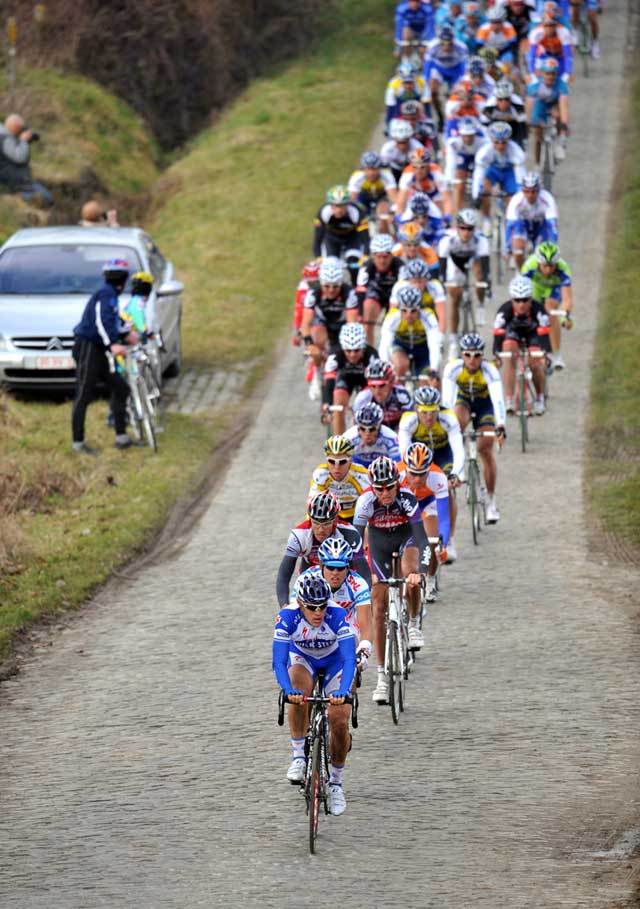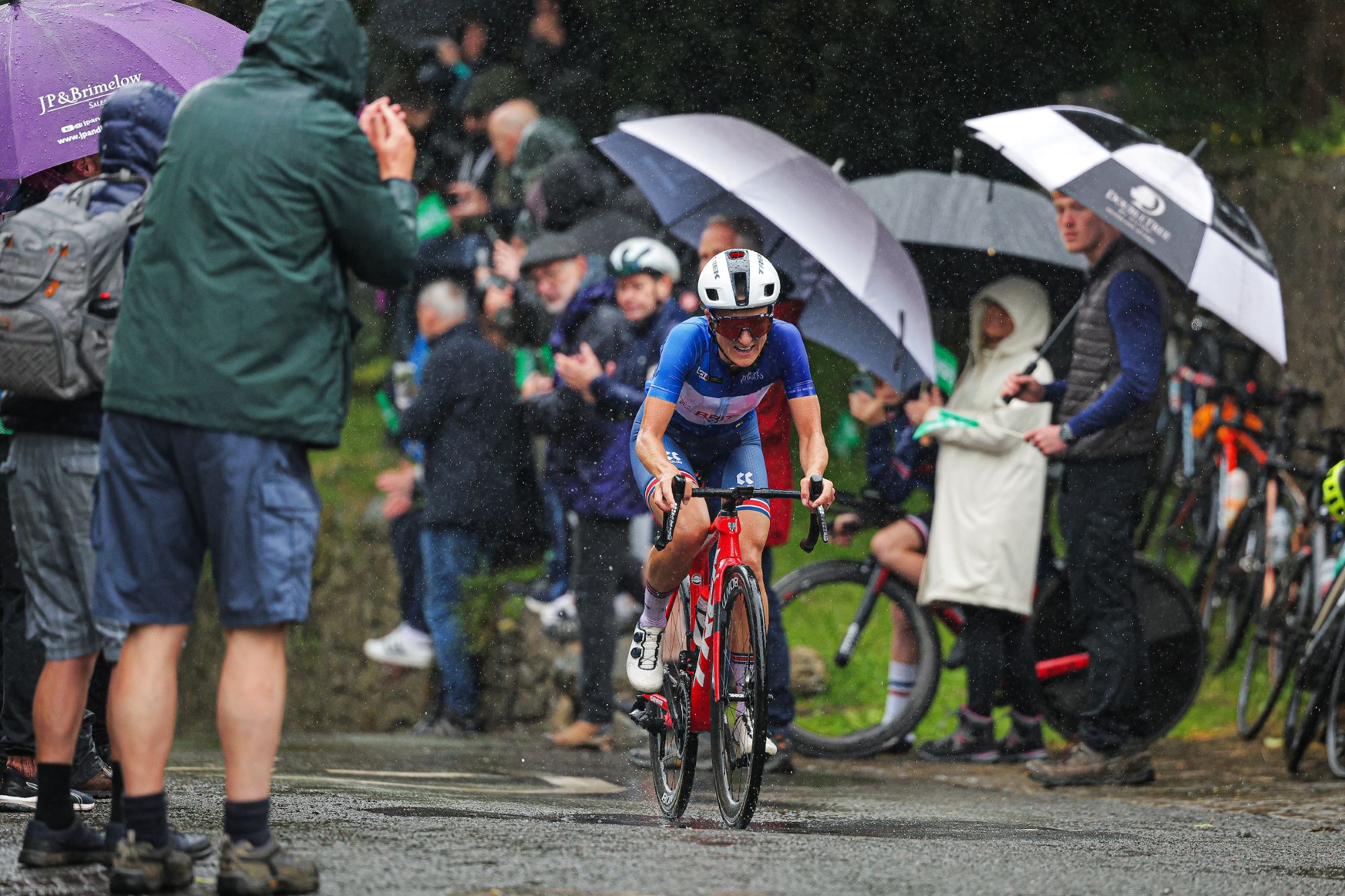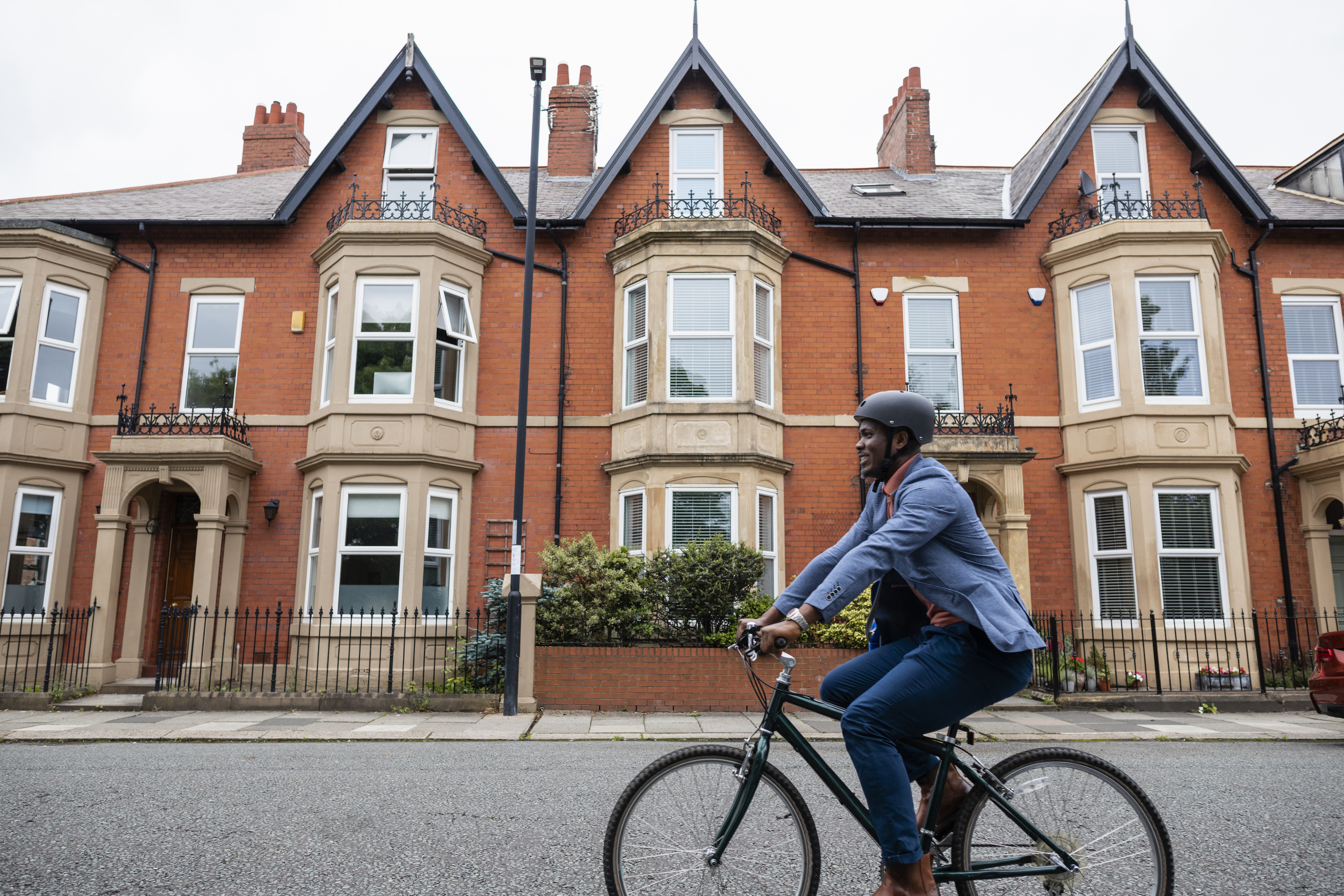Het Nieuwsblad diary: A weekend in Belgium

Cycling Weekly takes a look back at the opening Belgian Classic of the season, Het Nieuwsblad, which used to be called Het Volk, but has now had its name changed to something less catchy for commercial reasons.
| CERVÉLO?S H-FORCE |
Cervélo are demonstrating that the key to a successful cycling team is to create a unit that is greater than the sum of its parts.
Although you can hardly call a team that had the clout to sign Tour de France champion Carlos Sastre and former green jersey winner Thor Hushovd as a small-time outfit, if you took those two out of the roster, it didn?t scream winning potential.
But six weeks into the season and Cervélo have already impressed. They dominated in Qatar, where Roger Hammond won the opening stage and was third overall. Hushovd then won a stage in California, Heinrich Haussler won twice in the Algarve, before the Norwegian blitzed his way to victory in Charles de Kerchovelaan on Saturday.
It seems if your surname begins with an ?H? and you ride for Cervélo, you can do anything. If Jeremy Hunt had won Kuurne-Brussels-Kuurne on Sunday instead of finishing third, it would have begun to look decidedly spooky.

Thor Hushovd adds Het Nieuwsblad to his Ghent-Wevelgem win of a few years ago. Now for the Tour of Flanders or Paris-Roubaix, perhaps? Photo by Graham Watson
| RABOBANK'S CREDIT CRUNCHED |
Rabobank were so strongly represented in the final stages of Het Nieuwsblad it was, surely, their race to lose.
Get The Leadout Newsletter
The latest race content, interviews, features, reviews and expert buying guides, direct to your inbox!
Their rider Maarten Tjallingii was one of the four riders disqualified for going through a closing railway crossing. They were chasing the lead group at the time, but even that mishap didn't weaken Rabobank's hand too much.
Sebastian Langeveld and Heinrich Haussler of Cervélo attacked. Rabobank's Nick Nuyens was in the chase trio with Philippe Gilbert and Frédéric Amorison, but after some strong chasing from Quick Step's Sylvain Chavanel, they were caught.
Langeveld and Haussler's capture seemed inevitable but there it took some time and, with Juan Antonio Flecha, Nuyens, Bram Tankink and Joost Posthuma in the group, the Dutch squad looked in control.
Some viewers may have been puzzled as to why the Rabobank riders started attacking on the run-in when Langeveld was still away.
Langeveld is not as fast in the sprint as Haussler, and would probably have ended up with second place. By bringing the gap in, Rabobank hoped to spark a series of counter-attacks knowing they had the strength in numbers to have more than a couple of bites at the cherry.
As it was, Langeveld and Haussler stayed out there too long, meaning a sprint, rather than a late attack up the final drag. Even without the disruption caused by the crashes, Rabobank didn't have anyone fast enough to beat Hushovd.
| ORGANISED CHAOS |
The camera work at the finish of Saturday?s Het Nieuwsblad left a lot to be desired.
In fact, the whole day was a little chaotic, with members of the public driving on the course just minutes before the race was due to pass.
There is a temptation to think that every bike race held in Belgium, France, Italy or Spain goes ahead without a hitch, as if there is something in the genetic make-up of the race organisers in cycling?s traditional strongholds that ensures perfection.
It isn?t necessarily the case, but there is one big difference. In Belgium, if a car driver finds him or herself in the wrong place at the wrong time, they pull over as far as possible, or do whatever they can to get out of the way. You can?t say that always happens in Britain.
That?s because cycling is ingrained in the culture and people know what to expect when they see the crowds and the cars and then the peloton.
The TV coverage of the finish was very unfortunate, though. As the host broadcaster of the Tour of California found recently, you can get everything more or less right for three or four hours, but if you screw up the finish, you may as well not have bothered.
In this case, though, the broadcaster wasn?t really to blame, the race directors were. There were far too many cars in the road ahead of the bunch and they completely obscured the crashes and the drama of the uphill sprint.
There should be one vehicle for the race commissaire, not four or five for VIPs and other hob-nobbers.
It wasn?t until the television showed the overhead view that you could work out what happened. The main crash seemed innocent enough. Sebastian Langeveld drifted to the left as he was swept up by the chasers, only for Filippo Pozzato to brush into him and go down.
| BURGHARDT BACK ON FORM |
Before Het Nieuwsblad Brian Holm told me that Marcus Burghardt was in good form and gunning for a result.
The 25-year-old won Ghent-Wevelgem for T-Mobile a couple of years ago. That was the day when his team-mate Roger Hammond took second place too.
Last spring was ruined by a knee injury, which flared up at the Tour of the Algarve in February and ruled him out until May.
He recovered in time to win a stage during the final week of the Tour de France, but Holm reckons the big German is ready to challenge on the cobbles again.
He wasn?t wrong, because Burghardt was fifth on Saturday. Mind you, his website needs looking at if only for the ?quirky? Euro pop soundtrack.
www.marcus-burghardt.com
| THE GOOD, THE BAD AND THE AWFUL |
When the big races start, cyclingweekly.co.uk is not afraid to stick its neck out by predicting how the top 10 will turn out, even if it means red-faced humiliation.
So, this is how our tips got on at Het Nieuwsblad.
1 Sylvain Chavanel ? finished 17th
Did a lot of work for team-mate Tom Boonen and was not, as we?d thought, the protected man, despite his recent good form in the Algarve
2 Greg Van Avermaet ? 4th
Just missed out on the podium in the sprint
3 Edvald Boasson Hagen ? 104th
Let?s gloss over that one shall we? Brian Holm did say he?d been feeling under the weather in the lead up to the race
4 Martijn Maaskant ? 48th
In the main group, but didn?t show his hand
5 Nick Nuyens ? 14th
Looked lively. Got blocked by the crash in the sprint, which ruined his chances of a top 10 place
6 Philippe Gilbert ? 15th
The man of the race. Looked so strong on the Molenberg, and chased the front two Haussler and Langeveld hard, without success
7 Filippo Pozzato ? 92nd
Crossed the line battered and bruised after crashing just a few hundred metres from the line. Would have been top 10 but for that. Oh yes
8 Andreas Klier ? 7th
Kerr-ching. Bullseye. Back of the net
9 Leif Hoste ? 89th
Clearly saving his form for the Tour of Flanders. Ahem
10 Gerald Ciolek ? 127th
Was going well until he crashed
| WHAT?S IN A NAME? |
Watching the teams unload their bikes on Saturday it struck me that there?s a lot more to the world of bikes than Trek and Specialized.
Cycling Weekly?s Tech experts will testify that I am not exactly an authority when it comes to telling carbon-fibre from scandium (is this even right?)
To my mind a bike is an inanimate object that does not have a story to tell. And once you get above about £3,000 in price I can?t tell the difference between them anyway. I once tried to argue that if you took two bikes that cost the same, the only thing that mattered was whether it was red or blue. I still haven?t lived that down.
So mine is an aesthetic eye. Like the philistine art critic who knows what he likes and likes what he bloody well knows, mine is a knee-jerk reaction based mostly on the shape of the tubes, the paintjob, the name on the frame and the typeface they?ve used.
But I was impressed by the diversity on show in Ghent?s Sint-Pietersplein on Saturday. There were 25 teams present, and between them they used 22 different brands of bike.
Specialized and Ridley were the only companies to supply more than one team.
To my eye, the French companies Look, Time and Lapierre had the best-looking bikes. Giant?s new all-white Rabobank frame is by far the ugliest, with its boxy down tube.
Of the relatively obscure there were Kuota, Fuji, Koga Miyata and Batavus.
But I?ll freely admit I?d never heard of either Author (PSK Whirlpool?s bikes) or Granville (Veranda Willems). Come to that I wasn?t too familiar with the teams either.
Would I ride a Granville? Not in this country, that?s for sure. Anyone of an age old enough to remember the hapless bike-riding shop assistant of the same name in the sitcom Open All Hours (still available to watch on moronically-named cable channel Dave) knows the jokes would come thick and fast if you turned up to the club run on one of those.
WHO RODE WHAT?
Author ? PSK Whirlpool
Batavus ? Vacansoleil
BH ? AG2R
Cannondale ? Liquigas
Canyon ? Silence-Lotto
Cervélo ? Cervélo Test Team
Colnago ? Landbouwkrediet
Eddy Merckx ? Topsport Vlaanderen
Felt ? Garmin-Slipstream
Focus ? Milram
Granville ? Veranda Willems
Koga Miyata ? Skil-Shimano
Fuji ? Elk Haus
Giant ? Rabobank
Kuota ? Agritubel
Lapierre ? Française des Jeux
Look ? Cofidis
Ridley ? Katusha and Palmans-Cras
Scott ? Columbia
Specialized ? Quick Step, Saxo Bank and ISD
Time ? Bbox Bouygues Telecom
Trek ? Astana
| WHAT CW DID THIS WEEKEND |
We get quite a lot of readers asking what we did, where we stayed and where we ate and what we did.
However, cyclingweekly.co.uk is not a travel agent, and you follow our recommendations at your own risk.
We travelled over quite late on Thursday night and stayed in Dunkirk before getting up early on Friday morning and making the 90-minute drive to Oudenaarde.
That?s where the Tour of Flanders museum (Centrum Ronde Van Vlaanderen ? www.crvv.be) is, and it?s where a number of well-signposted rides start and finish.
For a few euros you can park in the centre of the square, buy a map from the museum shop ? served by Freddy Maertens, no less ? and then roll out following the signs.
We started off on the orange route, which packs 10 hills into 72 kilometres, but because of the shortage of time, we had to cut our ride short at the Koppenberg. Before that we had ridden the Kluisberg (sweeping and smooth), Knokteberg (steep, rutted, and even steeper at the top), Oude Kwaremont (long, steady, cobbled) and Paterberg (vicious, cobbled, mercifully short). There are showers in the museum for cyclists to use for just a couple of euros.
On Friday evening we stayed in the Ibis hotel in the centre of Kortrijk and dined at the Café Beethoven, which specialised in meat fondue, where you dip your raw meat into a tub of oil heated over a flame. We opted for the safer Chateaubriand option, and very nice it was too.
Race day is never anything other than hectic, but our job for the day was to try to see the race as many times as possible so our photographer Rupert could capture some atmospheric shots. I?d been warned he?d climb into a tree at some point, and at the Pottelberg he didn?t disappoint.
We left Ghent shortly before the race rolled out and headed straight for the Leberg, the first climb of the day. This is a crucial point in the race because everyone wants to be near the front. The race sweeps over a long section of cobbles and round a tricky, downhill, cobbled left-hand bend before hitting the climb.
After a snack in the Café den Drijhaard around the corner, we saw the break and the bunch through before dashing to the car.
About a hundred other fans had the same idea as us, to cut across country to the fourth climb, Ten Bosse. The fine weather had brought the crowds out on bikes, in cars and there was also an intrepid bunch on quad bikes.
Ten Bosse is not the prettiest of spots. It?s a residential back street that rises above Brakel. The hill is strategically important in the Tour of Flanders because it comes quite close to the end, but at Het Nieuwsblad it?s just another climb, and the bunch powered up it a couple of minutes behind the break, filling the width of the road.
At the Pottelberg, 30 kilometres later, the race situation had changed, with the leaders being pursued by four chasers on the smooth, twisty climb that heads up through the trees. Those four were later disqualified for failing to stop for a level crossing which was lowering.
Our fourth and final point of the race was the best and most dramatic. The Molenberg is a great climb. The sharp right-hand bend at the bottom and the narrow entrance onto the cobbles means that all but the first 10 riders have to slow to a crawl.
The cobbles are uneven, rutted and have sunk in places as they jolt over a little bridge and then hit the steep part of the hill.
Just on the left hand side, about halfway up, the organisers barrier off a section of a side road and a few seconds before the riders arrived, a swarm of motorbikes carrying photographers arrived.
It?s quite a comical scene, as the photographers leap off the bikes, some losing their footing as they jump onto the cobbles and compete for the best vantage point, jostling each other for the perfect shot.
Once the break had gone, so they hurriedly remounted and all roared off, happy in the knowledge that they were racing off together with exactly the same picture saved on their memory cards.
Philippe Gilbert looked very strong as he pushed clear of the main chase group on the Molenberg, but the abiding memory is always of the riders in the bunch and at the back. While the leaders are trying to do something in the race, these guys are just battling to finish. There were some tortured faces and miserable expressions in the bunch.
With the race ahead of the fastest schedule because of the still conditions, there was no way we were going to get back to Ghent in time for the finish, so we settled for watching the finale on television in a nearby bar, an experience which made you appreciate the UK?s smoking ban.
When Het Volk (sorry, Nieuwsblad) finishes, there is always a feeling that the hors d?oeuvre is over and the main meal is yet to come. But with more than a month to go until the Tour of Flanders arrives, it is a long wait which serves only to heighten the appetite.
You can see photographer Rupert Fowler?s pictures in the next issue of Cycle Sport.

Pounding over the cobbles. The nightmare gets worse the further back you go. Photo by Graham Watson
RELATED LINKS
Hushovd wins Het Nieuwsblad
Boonen triumphs at Kuurne-Brussels-Kuurne

Thank you for reading 20 articles this month* Join now for unlimited access
Enjoy your first month for just £1 / $1 / €1
*Read 5 free articles per month without a subscription

Join now for unlimited access
Try first month for just £1 / $1 / €1
Sports journalist Lionel Birnie has written professionally for Sunday Times, Procycling and of course Cycling Weekly. He is also an author, publisher, and co-founder of The Cycling Podcast. His first experience covering the Tour de France came in 1999, and he has presented The Cycling Podcast with Richard Moore and Daniel Friebe since 2013. He founded Peloton Publishing in 2010 and has ghostwritten and published the autobiography of Sean Kelly, as well as a number of other sports icons.
-
 FDJ-Suez, SD Worx-Protime, Lidl-Trek confirmed for Tour of Britain Women as strong list of teams announced
FDJ-Suez, SD Worx-Protime, Lidl-Trek confirmed for Tour of Britain Women as strong list of teams announced18 teams set to take part in four-day WorldTour stage race
By Tom Thewlis
-
 Cyclists could face life sentences for killing pedestrians if new law passed in England and Wales
Cyclists could face life sentences for killing pedestrians if new law passed in England and WalesReckless cycling currently carries a maximum two-year jail term
By Tom Thewlis